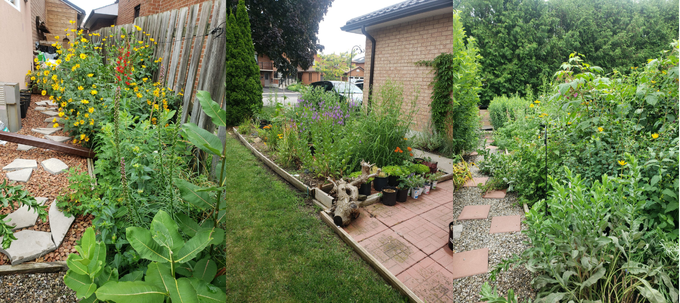"When we moved into this property 11 years back, there was grass (lawn) on 90% of the backyard and front yard. My knowledge of gardening was also very basic. The first three years I made sure that my grass was lush green with no weeds. I soon realized I was spending too much time and energy to maintain grass in my backyard. I started reading about plants in general and then native plants online. I was always interested in nature and the outdoors and soon saw the great opportunity to invite wildlife into my backyard by growing native plants. Hence, I started the journey of planting (mostly) native and perennial species.
I drew out a plan, created flower beds, rejuvenated the soil (mostly clay) and started planting. I have about 70% native plants and other perennials and some annuals to add colour to the landscape. The annuals also attract lots of bees. I have seen all kinds of bees (the bumble bee and the honeybee are the only ones I can identify) and butterflies (2 types of swallowtails, monarch and false monarch, sulfurs and some moths, lady bugs, dragon flies and a variety of insects.) Bird life has been incredible - they especially seem to use the well-established cedar border. We have seen warblers this spring - May 2020 - black and white, magnolia, yellow, palm, chestnut sided, bay breasted, American redstart, cape may; two types of flycatchers; 4 species of sparrow; hummingbirds; and all the other common backyard birds that one can see in the suburban setting. I have started growing a few vegetables this year and am excited to see the initial results. Overall, our back yard is the place to be for us from April to October. Seeing the flowers bloom in various colours throughout the growing season and the changing insects and bird life from spring to fall is really satisfying and encourages one to do more.
Since 2020, we have transformed most of our front yard from lawn to two 3 beds of native flowers and grasses. They are mostly prairie species – big blue stem, little blue stem and Indian grass are the three native warm season grasses. Other than that we have grey headed cone flower, Virginia mountain mint, Stiff goldenrod, Hoary vervain, Anise hyssop, Canada vetch, Canada anemone, Dense blazing star, and several other native annual and perennial species.

Photos: Mohan Iyer
In the backyard too, we have added new native species like cardinal flower, blue lobelia, blue vervain, bush honey suckle, purple coneflower, hoary beard tongue, snake root, butterfly milkweed, swamp milkweed, common milkweed and several other native species that attract several species of bees. We have also set up a bee hotel which has been a very successful project. We now have metallic bees, sweat bees, hover flies, and several other bees that are not only using the flowers as a food source (pollen and nectar) but are also using the bee hotel to nest. A small pond has become the center point for all resident and migratory birds as they are always eager to take a quick bath in the cool water.
Sub-urban yards are a great place to start planting native plants. There are wide variety of them that can suit the GTA climate zone and nurseries are aware of the demand for such native plants and beginning to cater to the requirements of conscious gardeners who want to make a switch from the conventional lawn (grass) to a native garden."
